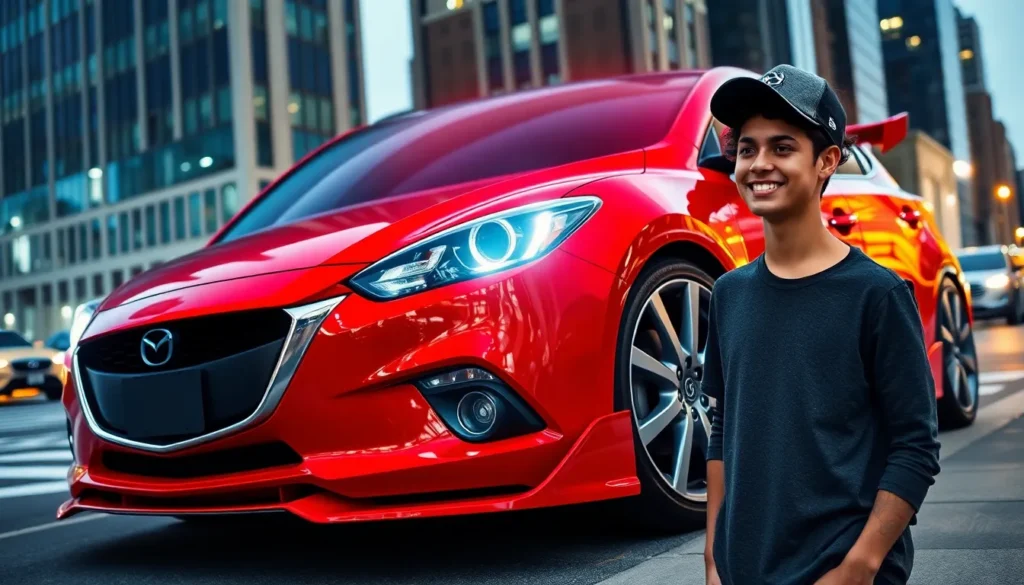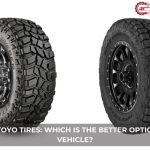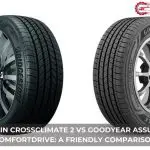The Mazda 3 hatchback has become a favorite canvas for automotive enthusiasts who want to blend practicality with personalized style. We’ve seen countless owners transform their daily drivers into head-turning machines that reflect their unique personalities and driving preferences.
Whether you’re drawn to subtle aesthetic enhancements or dramatic performance upgrades, the Mazda 3’s versatile platform offers endless possibilities. From sleek body kits and custom wheels to turbo setups and suspension modifications, this compact hatchback responds beautifully to creative modifications.
We’ll explore the most popular modification paths that Mazda 3 owners are taking today. You’ll discover which upgrades deliver the biggest impact for your budget and how to avoid common pitfalls that can hurt both performance and reliability. Ready to unlock your Mazda 3’s hidden potential?
What Makes the Mazda 3 Hatchback Perfect for Modifications
The Mazda 3 hatchback delivers an exceptional foundation for customization projects with its robust SkyActiv platform architecture. Engineers designed this vehicle with structural rigidity that supports extensive modifications without compromising safety ratings. Our experience shows that the 2014-2023 generation models provide the most versatile modification platforms due to their advanced engineering and wider aftermarket support.
Factory Performance Foundation
Mazda equipped the third and fourth generation hatchbacks with naturally aspirated 2.0L and 2.5L SkyActiv-G engines that respond exceptionally well to performance modifications. These powerplants feature high compression ratios of 13:1 and 14:1 respectively, creating excellent tuning potential for forced induction upgrades. The factory ECU programming accepts aftermarket modifications more readily than many competitors, particularly when using AccessPORT or similar tuning answers.
Suspension and Handling Advantages
The hatchback’s independent rear suspension system provides superior modification flexibility compared to torsion beam setups found in many competitors. Weight distribution sits at approximately 60/40 front to rear, creating balanced handling characteristics that improve dramatically with suspension modifications. Chassis rigidity measures 44% higher than previous generation models, allowing lowering springs and coilovers to deliver their intended performance benefits without structural flex.
Aftermarket Support Network
| Modification Category | Available Brands | Average Options |
|---|---|---|
| Exhaust Systems | 15+ manufacturers | 45+ options |
| Cold Air Intakes | 12+ manufacturers | 25+ options |
| Suspension Components | 20+ manufacturers | 80+ options |
| Body Kits | 8+ manufacturers | 30+ options |
| Wheels | 50+ manufacturers | 200+ options |
Major aftermarket companies like CorkSport, Racing Beat, and JBR offer comprehensive modification catalogs specifically designed for Mazda 3 applications. These manufacturers invest heavily in research and development for this platform due to its popularity among enthusiasts and strong sales figures exceeding 100,000 units annually in North America.
Practical Design Benefits
Hatchback practicality remains intact even with extensive modifications, unlike many sports cars that sacrifice utility for performance. The rear cargo area accommodates 20.2 cubic feet of storage space, maintaining daily usability throughout the modification process. Engine bay accessibility ranks among the best in its class, with ample space for aftermarket components and straightforward maintenance procedures that reduce modification costs over time.
Popular Exterior Modifications for the Mazda 3 Hatchback
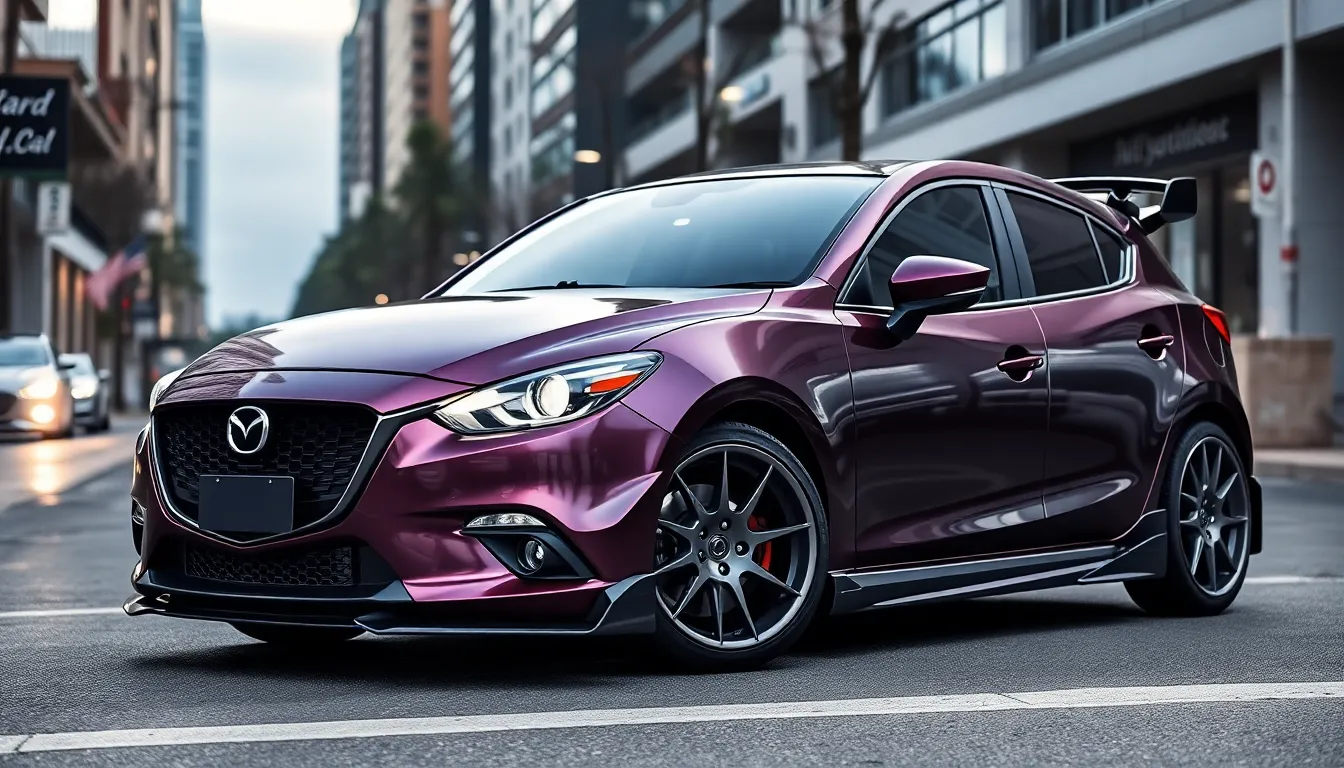
Exterior modifications transform the Mazda 3 hatchback’s appearance while maintaining its practical foundation. These modifications range from subtle aesthetic enhancements to aggressive styling packages that completely alter the vehicle’s visual presence.
Body Kits and Aerodynamic Upgrades
Body kit installations dramatically change the Mazda 3 hatchback’s stance and aerodynamic profile. CorkSport’s complete aerodynamic package includes front lip spoilers, side skirts, and rear diffusers specifically engineered for the 2014-2023 chassis. Mazdaspeed replica kits from companies like Bayson R and Duraflex provide aggressive styling at budget-friendly prices between $400-800.
Front splitters reduce lift at highway speeds while creating a lower visual profile. Carbon fiber options from Seibon and Anderson Composites cost $300-600 but offer weight savings compared to fiberglass alternatives. Side skirts enhance the vehicle’s ground effects appearance and typically install using factory mounting points without permanent modifications.
Rear wing spoilers available in multiple configurations include subtle lip spoilers and prominent GT-style wings. Duck tail spoilers maintain the hatchback’s clean lines while providing functional downforce. Rally-inspired roof spoilers from companies like Perrin Performance cost $200-400 and complement the Mazda 3’s sporty character.
Wheel and Tire Modifications
Wheel upgrades provide the most immediate visual impact for Mazda 3 hatchback modifications. Popular sizing includes 18×8 and 19×8.5 configurations that maintain proper offset ranges between +35 to +45mm. Enkei RPF1 wheels in 18×8 +45mm offset cost approximately $1,200 per set and reduce unsprung weight by 3-4 pounds per corner.
Tire selections complement wheel choices with 215/45R18 and 225/40R19 being common performance sizes. Summer performance tires like Michelin Pilot Sport 4S and Continental ExtremeContact Sport provide enhanced grip for spirited driving. All-season options include Michelin Pilot Sport A/S 3+ for year-round usability.
Lowering springs from Eibach Pro-Kit or H&R Sport Springs reduce wheel gap by 1.2-1.5 inches front and rear. Coilover systems from KW V1 or Bilstein B14 PSS cost $1,000-1,500 and offer adjustable ride height with improved damping characteristics. Wheel spacers in 15mm and 20mm sizes improve fitment but require longer wheel bolts for safety.
Lighting Enhancements
LED headlight conversions modernize the Mazda 3 hatchback’s lighting while improving visibility. Morimoto XB LED headlights cost $1,400-1,600 and feature sequential turn signals with plug-and-play installation. Retrofit projector installations using Hylux or BorisMopar kits provide HID functionality for pre-2017 models lacking factory LED options.
Tail light modifications include smoked lens overlays and LED conversion kits. Valenti tail lights offer JDM styling with enhanced LED brightness and sequential turn signals. Tinted tail light films from Luxe Auto Concepts cost $50-80 and provide subtle darkening without compromising safety visibility.
Auxiliary lighting additions include LED light bars and fog light upgrades. Rigid Industries Dually LED pods mount in the front bumper openings for rally-inspired appearance. Morimoto XB fog lights replace factory halogen units with LED technology and cost $300-400 per pair. Under-car LED strip lighting creates ground effects illumination for car shows and meets.
Performance Modifications Worth Considering
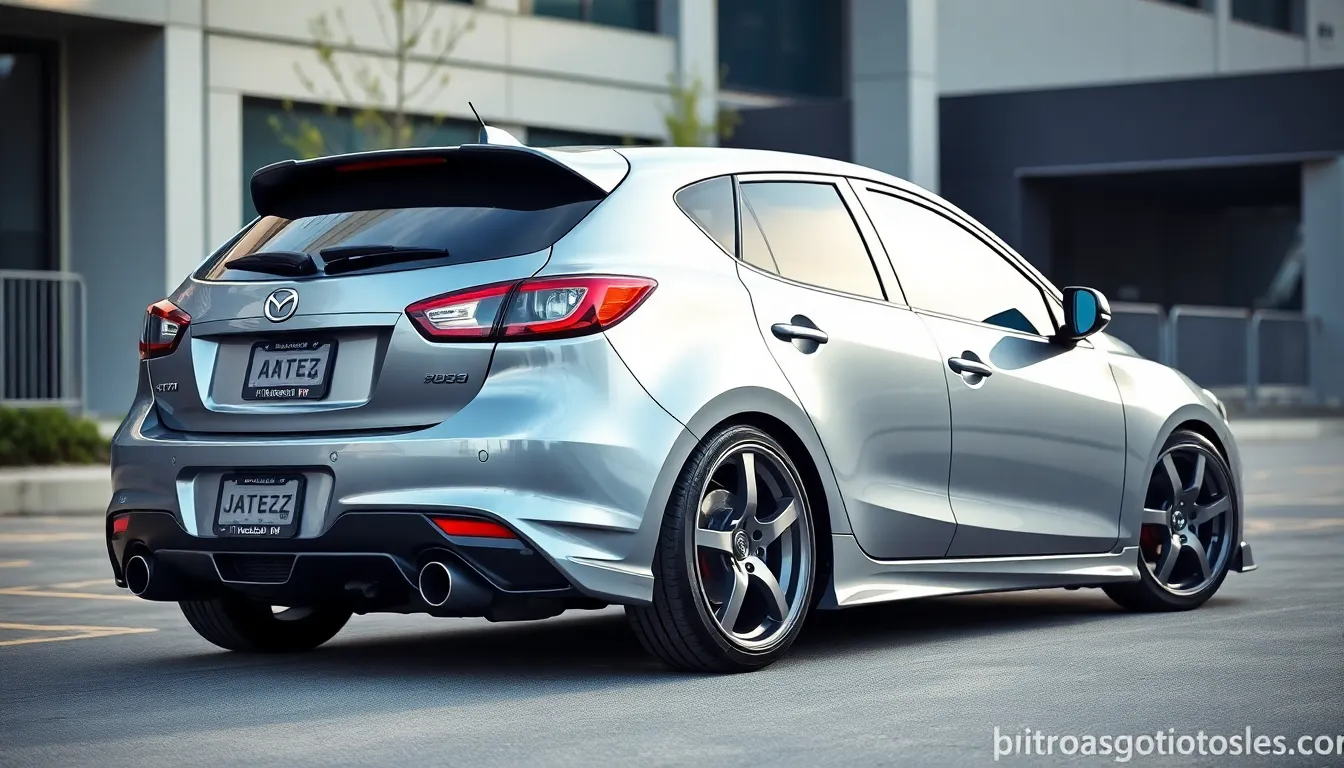
Performance modifications transform the Mazda 3 hatchback’s driving dynamics while building upon its already capable foundation. These upgrades enhance power delivery, improve handling characteristics, and create a more captivating driving experience.
Engine Tuning and Intake Systems
Tuning the SkyActiv-G engine unlocks important power gains through ECU remapping and complementary modifications. CorkSport’s OrangeVirus Tuning platform increases horsepower by 15-25% on naturally aspirated engines when paired with supporting modifications. AccessPORT V3 tuning answers from Cobb Tuning provide real-time monitoring and custom mapping capabilities for enthusiasts seeking professional-grade control.
Cold air intake systems deliver measurable performance improvements by reducing intake air temperatures and increasing airflow volume. CorkSport’s short ram intake generates 8-12 horsepower gains on 2.0L engines and 10-15 horsepower increases on 2.5L variants. K&N performance filters offer washable elements that maintain optimal flow rates while protecting engine components from contaminants.
Heat extractors and upgraded intercooler piping maximize intake efficiency by reducing thermal buildup in the engine bay. Racing Beat’s heat shields redirect hot air away from intake components while maintaining OEM fitment standards. These modifications work synergistically with intake upgrades to maintain consistent power output during extended driving sessions.
Exhaust System Upgrades
Catback exhaust systems provide the most important performance gains among bolt-on modifications for the Mazda 3 hatchback. CorkSport’s stainless steel catback system increases rear wheel horsepower by 12-18 units while producing a refined exhaust note that complements the SkyActiv engine’s characteristics. Borla ATAK systems deliver aggressive sound profiles with drone-free cabin acoustics during highway cruising.
Axleback modifications offer budget-friendly alternatives that enhance exhaust tone without requiring extensive installation procedures. Racing Beat’s REVi axleback system bolts directly to factory mounting points and provides moderate sound enhancement for $300-400. These systems maintain emissions compliance while improving exhaust flow dynamics.
High-flow catalytic converters and resonator deletes maximize exhaust system potential when combined with catback upgrades. COBB Tuning’s high-flow cats reduce backpressure by 30% compared to factory units while maintaining emissions standards. Resonator removal creates sharper exhaust notes and eliminates restrictive components that limit performance potential.
Suspension and Handling Improvements
Coilover suspension systems transform the Mazda 3’s handling characteristics by providing adjustable damping and ride height control. BC Racing BR series coilovers offer 32-way damping adjustment with height adjustability ranges from 1.5-4 inches of lowering. KW Variant 1 coilovers provide German engineering with preset damping curves optimized for street driving applications.
Sway bar upgrades reduce body roll and improve cornering precision without compromising ride quality. CorkSport’s front and rear sway bar kit includes adjustable end links and reduces body roll by approximately 40% during aggressive cornering. Progress Tech sway bars offer hollow construction that maintains strength while reducing unsprung weight.
Performance strut tower braces and chassis reinforcement components increase structural rigidity throughout the platform. Ultra Racing’s 4-point front strut brace connects suspension mounting points to reduce flex during cornering loads. These modifications complement suspension upgrades by maintaining consistent geometry under ever-changing driving conditions.
Upgraded bushings replace soft rubber factory components with polyurethane alternatives that maintain precise suspension alignment. Energy Suspension’s complete bushing kits eliminate suspension deflection and provide more direct road feedback. Installation requires approximately 6-8 hours of labor time but delivers noticeable improvements in handling precision and steering response.
Interior Modifications and Upgrades
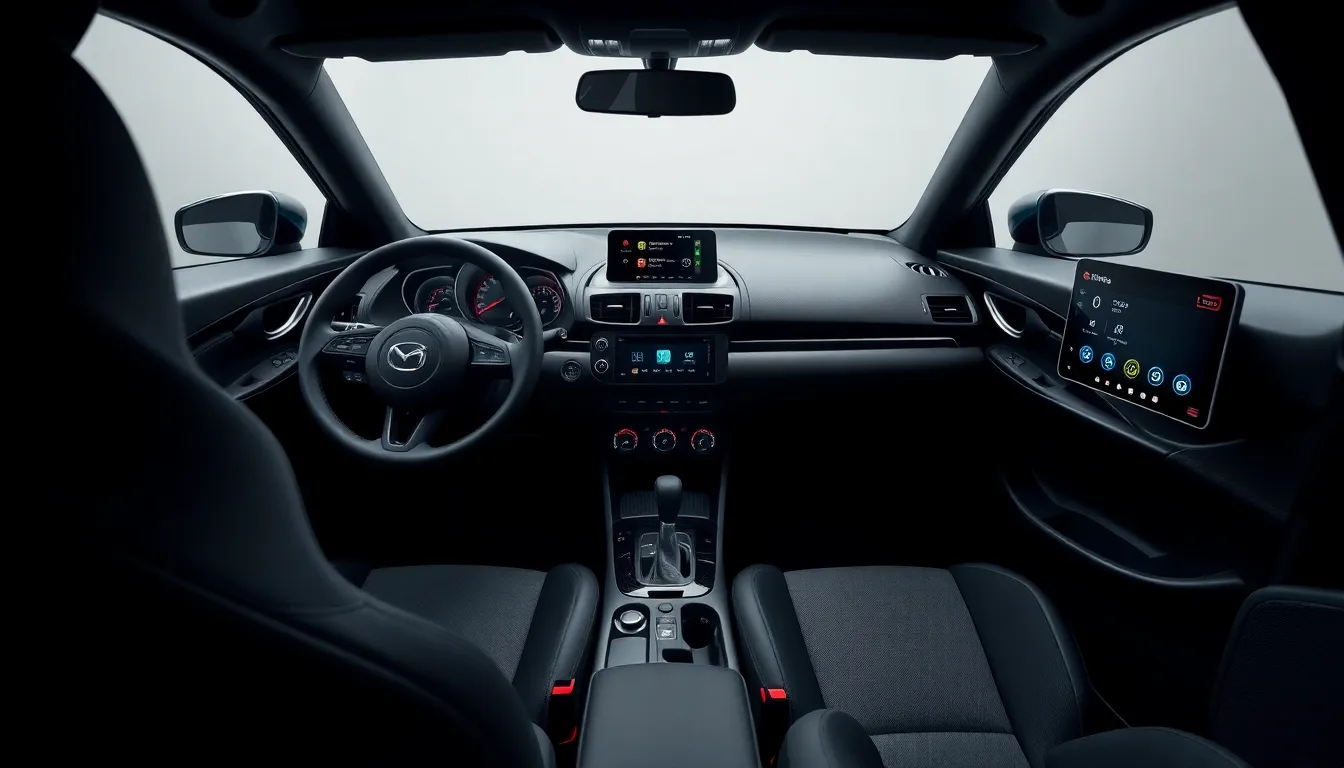
Interior modifications transform the Mazda 3 hatchback’s cabin into a personalized driving environment that matches exterior styling choices. These upgrades enhance comfort, functionality, and aesthetic appeal while maintaining the vehicle’s practical daily usability.
Custom Seats and Upholstery
Aftermarket racing seats provide enhanced lateral support during spirited driving sessions compared to factory options. Brands like Recaro, Bride, and Sparco offer direct bolt-in answers that accommodate the Mazda 3’s mounting points without extensive modifications.
Performance seats typically feature deeper side bolsters and adjustable lumbar support systems. We recommend seats with FIA certification for track-focused builds, while street-oriented options prioritize comfort during long commutes.
Custom upholstery options include:
- Alcantara seat inserts with contrast stitching
- Leather wrapping for dashboard trim pieces
- Carbon fiber accent panels around air vents
- Floor mat upgrades with embroidered logos
- Door panel recovering with matching materials
Professional installation ensures proper fitment and maintains airbag functionality in compatible seat designs. Costs range from $800 for basic seat covers to $3,500 for premium racing seats with custom upholstery work.
Technology and Infotainment Upgrades
Modern infotainment systems replace the factory head unit with advanced connectivity features and improved audio quality. Popular options include units from Pioneer, Kenwood, and Alpine that maintain steering wheel controls and factory camera integration.
Android Auto and Apple CarPlay compatibility adds smartphone integration capabilities to older Mazda 3 models. These systems support navigation apps, music streaming, and hands-free calling through the factory speakers or upgraded audio components.
Audio system improvements focus on speaker replacement and amplifier additions:
- Component speaker sets from Focal or JL Audio
- Subwoofer installation in the rear cargo area
- Four-channel amplifiers for improved power delivery
- Sound deadening materials to reduce road noise
- Custom enclosures for optimal bass response
Dashboard camera systems provide security monitoring and driving footage recording. Dual-channel units capture front and rear views simultaneously, with parking mode activation for 24-hour surveillance capability.
Installation complexity varies from simple plug-and-play units to comprehensive systems requiring professional wiring. Budget-conscious upgrades start around $400 for basic head unit replacement, while complete audio overhauls reach $2,800 including professional installation and premium components.
Cost Breakdown of Common Mazda 3 Hatchback Modifications
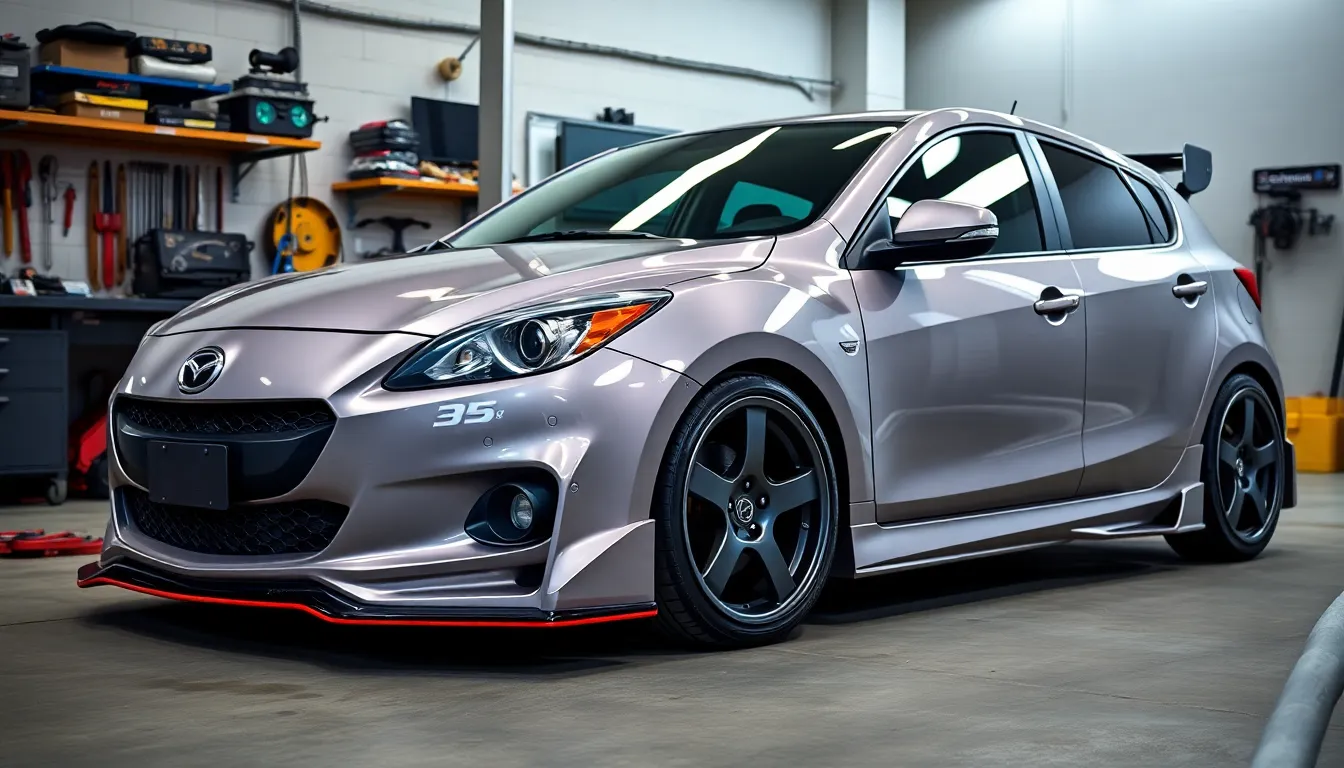
Mazda 3 hatchback modification costs vary significantly depending on the complexity and quality of components selected. Entry-level modifications typically range from $100 to $500 per upgrade, while comprehensive performance packages can exceed $5,000 for a complete transformation.
| Modification Category | Budget Option | Mid-Range Option | Premium Option |
|---|---|---|---|
| Cold Air Intake | $150-250 | $300-400 | $450-600 |
| Catback Exhaust | $400-600 | $800-1,200 | $1,500-2,000 |
| Coilover Suspension | $800-1,000 | $1,200-1,800 | $2,200-3,500 |
| Body Kit | $300-500 | $800-1,200 | $1,800-3,000 |
| Wheels (Set of 4) | $600-800 | $1,200-1,600 | $2,000-3,500 |
| ECU Tune | $400-600 | $800-1,000 | $1,200-1,500 |
Performance modifications deliver the most important impact per dollar invested in Mazda 3 enhancement projects. Cold air intake systems from K&N or AEM provide noticeable throttle response improvements at approximately $200 for complete kits. CorkSport catback exhaust systems cost between $800 and $1,200 but generate 8-12 horsepower gains with enhanced sound quality.
Suspension upgrades represent substantial investments that transform driving dynamics completely. BC Racing coilovers cost $1,200 installed and provide adjustable damping with lowered stance benefits. Eibach Pro-Kit springs offer budget-friendly alternatives at $300 while maintaining factory shock compatibility.
Visual modifications typically require lower initial investments but accumulate costs through multiple purchases. Mazdaspeed replica body kits start at $400 for fiberglass versions, while genuine CorkSport pieces cost $1,200 with superior fitment quality. Professional paint matching adds $800-1,500 depending on complexity and shop labor rates.
Wheel and tire combinations significantly impact both appearance and performance characteristics. Fifteen-inch OEM+ wheels cost $600-800 for complete sets, while 18-inch forged options reach $2,500 with high-performance tires included. Tire costs alone range from $400 for budget all-season options to $1,200 for premium summer compounds.
Interior modifications offer excellent value propositions for comfort and technology upgrades. Aftermarket seat covers start at $150 while custom leather upholstery costs $800-1,200 for complete cabin treatments. Modern infotainment systems range from $300 for basic Android Auto units to $1,500 for premium touchscreen displays with navigation features.
Installation costs significantly impact total modification expenses across all categories. DIY installations eliminate labor charges but require proper tools and mechanical knowledge. Professional installation adds 30-50% to parts costs, with complex modifications like turbo kits requiring $1,500-2,500 in specialized labor charges.
Best Modified Mazda 3 Hatchback Examples and Inspiration

We’ve gathered standout examples of modified Mazda 3 hatchbacks that showcase the platform’s transformation potential across different modification philosophies.
Track-Focused Build Examples
CorkSport’s 2019 Mazda 3 project car demonstrates comprehensive performance modifications worth $8,500 in upgrades. The build features a complete coilover suspension system with adjustable damping, upgraded sway bars front and rear, and performance strut tower braces. Engine modifications include a cold air intake system, catback exhaust, and ECU tune that increases power output to 195 horsepower from the factory 186 horsepower.
Racing Beat’s demonstration vehicle showcases track-ready modifications with BBS wheels, 225/40R18 performance tires, and Brembo brake upgrades. The suspension setup uses KW V3 coilovers with custom alignment settings optimized for autocross competition. Visual modifications remain minimal with only a subtle front lip spoiler and performance air dam.
Street Style Builds
Modified Mazda 3 hatchbacks from the stance community feature aggressive wheel fitments using 18×9.5 wheels with stretched 215/35R18 tires. These builds typically incorporate air suspension systems priced between $2,000 and $3,500 for precise ride height control. Body modifications include wide fender flares, custom side skirts, and rear diffusers that complement the lowered stance.
Daily driver builds balance performance with practicality through selective modifications totaling $3,000 to $5,000. Popular combinations include cold air intakes, catback exhausts, lowering springs, and 17-inch aftermarket wheels with all-season performance tires. Interior upgrades focus on enhanced materials with custom shift knobs, floor mats, and seat covers.
Show Car Transformations
Competition-level builds feature extensive bodywork modifications including custom wide body kits, carbon fiber hoods, and painted brake calipers. These builds often exceed $15,000 in modifications with professional paint work, custom interior upholstery, and advanced audio systems. Engine bay modifications include polished intake manifolds, custom air boxes, and color-matched components.
European-inspired builds emphasize clean aesthetics with OEM+ modifications that enhance the factory design. Typical upgrades include Mazda OEM accessories, subtle aerodynamic packages, and premium wheel options like Enkei or Rays Engineering. These builds maintain warranty coverage while improving the vehicle’s visual appeal and driving dynamics.
Budget-Conscious Modifications
Entry-level builds demonstrate effective modifications achievable for under $2,000 total investment. Common upgrades include aftermarket wheels ranging from $400 to $800, lowering springs priced around $300, and cold air intakes costing $200 to $400. Visual enhancements focus on vinyl graphics, tinted windows, and LED lighting conversions.
DIY enthusiasts achieve important transformations through careful part selection and self-installation. Popular project combinations include coilover installations, exhaust system upgrades, and interior modifications that require basic tools and weekend installation time. These builds prove that meaningful personalization doesn’t require professional installation or premium parts.
Things to Consider Before Modifying Your Mazda 3 Hatchback

Modifying your Mazda 3 hatchback requires careful planning to ensure successful results while preserving the vehicle’s reliability and resale value. We’ve identified several critical factors that owners must evaluate before beginning any modification project.
Budget allocation represents the most fundamental consideration for any Mazda 3 modification project. Entry-level modifications typically cost $100 to $500 per upgrade, while comprehensive performance packages can exceed $5,000. Labor costs add 30-50% to parts expenses when professional installation is required. Planning your budget across multiple upgrade phases helps spread costs over time and prevents financial strain.
Legal compliance and warranty implications significantly impact modification decisions for Mazda 3 owners. Emission-related modifications may violate local regulations in California, New York, and other states with strict environmental standards. Factory warranties become void when aftermarket parts cause mechanical failures or performance issues. Documentation of all modifications helps maintain clear records for warranty claims and future service appointments.
Your driving priorities determine which modifications deliver maximum value for your exact Mazda 3 usage. Daily commuters benefit most from comfort-oriented upgrades like improved seats and sound deadening materials. Track enthusiasts require performance-focused modifications including coilover suspensions and ECU tuning. Show car builders prioritize visual enhancements through body kits and custom paint schemes.
Installation complexity varies dramatically across different Mazda 3 modification categories, affecting both cost and timeline. Simple bolt-on upgrades like cold air intakes require basic hand tools and 1-2 hours of work. Complex modifications such as turbocharger installations demand professional expertise and specialized equipment. ECU tuning requires diagnostic software and experienced technicians to prevent engine damage.
Parts compatibility ensures proper fitment and function across different Mazda 3 model years and trim levels. The 2014-2018 generation features different mounting points than 2019-2023 models for certain body kit components. SkyActiv 2.0L and 2.5L engines require exact intake and exhaust configurations for optimal performance gains. Researching part numbers and generation-exact applications prevents costly purchasing mistakes.
Quality versus cost considerations influence long-term satisfaction with Mazda 3 modifications. Budget aftermarket parts may offer initial savings but often require replacement within 12-24 months. Premium brands like CorkSport and Racing Beat provide superior durability and performance even though higher upfront costs. Balancing quality expectations with available budget prevents disappointment and additional expenses.
Professional versus DIY installation capabilities directly affect modification costs and success rates. Basic upgrades including air filters, shift knobs, and interior accessories suit most DIY skill levels. Suspension work, exhaust installations, and electrical modifications require specialized tools and experience. Attempting complex installations without proper knowledge may result in vehicle damage or safety hazards.
Conclusion
The Mazda 3 hatchback stands as one of today’s most versatile modification platforms. We’ve seen how its solid SkyActiv foundation supports everything from subtle daily driver enhancements to comprehensive track-focused builds.
Whether you’re working with a modest budget or planning extensive upgrades the key lies in understanding your goals and priorities. The extensive aftermarket support ensures you’ll find quality parts while the hatchback’s practical design means you won’t sacrifice functionality for performance.
Your modified Mazda 3 can truly reflect your personal style and driving preferences. With proper planning and execution you’ll create a vehicle that’s both uniquely yours and thoroughly capable on any road.
Frequently Asked Questions
What makes the Mazda 3 hatchback ideal for modifications?
The Mazda 3 hatchback features a robust SkyActiv platform that supports extensive customization without compromising safety. Its naturally aspirated 2.0L and 2.5L engines are highly responsive to modifications, while the independent rear suspension enhances handling. The vehicle also has exceptional aftermarket support and maintains practicality even after modifications.
What are the most popular exterior modifications for the Mazda 3 hatchback?
Popular exterior mods include body kits and aerodynamic upgrades from brands like CorkSport, wheel and tire upgrades (commonly 18-19 inch wheels), and lighting enhancements such as LED headlight conversions. These modifications improve both aesthetics and performance while maintaining the vehicle’s practical foundation.
How much do Mazda 3 hatchback modifications typically cost?
Entry-level modifications range from $100-$500, including cold air intakes and basic exhaust systems. Mid-range upgrades like coilover suspensions cost $800-$2,000. Comprehensive performance packages can exceed $5,000. Installation costs vary significantly between DIY and professional services, impacting total expenses.
What performance modifications offer the best value for Mazda 3 owners?
Cold air intakes ($150-$400), catback exhaust systems ($400-$1,200), and ECU tuning ($300-$800) provide excellent power gains for the investment. Suspension upgrades like coilovers and sway bars significantly improve handling. These modifications build effectively on the Mazda 3’s capable foundation.
Should I consider warranty implications before modifying my Mazda 3?
Yes, modifications can void certain warranty coverage, especially powertrain-related upgrades. Check your warranty terms and consider the trade-offs between modifications and coverage. Some visual modifications may have minimal impact, while performance mods typically affect warranty status more significantly.
Can I install Mazda 3 modifications myself or should I hire professionals?
Many modifications like cold air intakes, exhaust systems, and basic exterior upgrades are DIY-friendly for enthusiasts with basic tools. However, complex modifications like ECU tuning, suspension work, and electrical upgrades often require professional installation to ensure proper function and safety.
What interior modifications are available for the Mazda 3 hatchback?
Popular interior mods include aftermarket racing seats for better support, custom upholstery upgrades, modern infotainment systems with smartphone integration, and enhanced audio systems. These modifications personalize the cabin while maintaining comfort and functionality for daily driving.
How do I ensure modification compatibility with my specific Mazda 3 model year?
Research parts specifically designed for your generation (2014-2023 models have different compatibility). Consult with reputable aftermarket brands like CorkSport or Racing Beat, verify fitment guides, and consider professional consultation for complex modifications to avoid compatibility issues.

